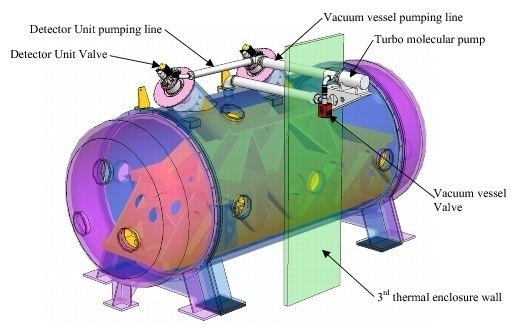 | ||
ESPRESSO (Echelle SPectrograph for Rocky Exoplanet- and Stable Spectroscopic Observations) is a third-generation, fiber fed, cross-dispersed, echelle spectrograph for the European Southern Observatory's Very Large Telescope (VLT) is the successor of a line of echelle spectrometers (CORAVEL, Elodie, Coralie, HARPS). It measures changes in the light spectrum with great sensitivity, and will be used to search for Earth-like planets via the radial velocity method. For example, our Earth induces a radial-velocity variation of 9 cm/s on our Sun; this gravitational "wobble" causes minute variations in the color of sunlight, invisible to the human eye but detectable by the instrument. The telescope light is fed to the instrument via a Coude-Train optical system and fibers. ESPRESSO is located in the VLT Combined-Coude Laboratory (incoherent focus) where a front-end unit can combine the light from up to 4 Unit Telescopes (UT) of the VLT.
Contents
ESPRESSO is scheduled to begin scientific operations in 2017.
Sensitivity
ESPRESSO will build on the foundations laid by the High Accuracy Radial Velocity Planet Searcher (HARPS) instrument at the 3.6-metre telescope at ESO’s La Silla Observatory. ESPRESSO will benefit not only from the much larger combined light-collecting capacity of the four 8.2-metre VLT Unit Telescopes, but also from improvements in the stability and calibration accuracy that are now possible (for example, laser frequency comb technology). The requirement is to reach 10 cm/s, but the aimed goal is to obtain a precision level of a few cm/s. This would mean a large step forward over current radial-velocity spectrographs like ESO's HARPS. The HARPS instrument can attain a precision of 97 cm/s (3.5 km/h), with an effective precision of the order of 30 cm/s, making it one of only two instruments worldwide with such accuracy. The ESPRESSO would greatly exceed this capability making detection of earth-like planets from ground based instruments possible. Installation and commissioning of ESPRESSO at the VLT is foreseen in 2016.
The instrument is capable of operating in 1-UT mode (using one of the telescopes) and in 4-UT mode. In 4-UT mode, in which all the four 8-m telescopes are connected incoherently to form a 16-m equivalent telescope, the spectrograph will reach extremely faint objects.
For example, (for G2V type stars):
ESPRESSO will focus the observations on the best-suited candidates: non-active, non-rotating, quiet G to M dwarfs. It will operate at the peak of its efficiency for a spectral type up to M4-type stars.
Instrument
ESPRESSO will use as calibration a laser frequency comb (LFC), with backup of two ThAr lamps. It will have three instrumental modes: singleHR, singleUHR and multiMR. In the singleHR mode ESPRESSO can be fed by any of the four UTs.
Status
The project is currently in its manufacturing phase. All design work is complete. ESPRESSO first laboratory light occurred on June 3, 2016.
Scientific Objectives
The main scientific drivers for ESPRESSO are:
These science cases require an efficient, high-resolution, extremely stable and accurate spectrograph.
Consortium
ESPRESSO is being developed by a consortium consisting of ESO and seven further scientific institutes:
